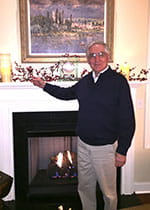The Challenge: Emphysema
It was 1981. John Sullivan, 35 years old, had just moved to Ohio. He stayed busy as a traveling salesman, husband, and father of two young kids.
During a routine physical, he was found to be in great shape, except for one small problem. His doctor discovered that John had emphysema.
Although he smoked, and had been coughing some, John didn’t fit the profile of a typical emphysema patient. His doctor sent him to a pulmonologist to find out why.
The diagnosis? John had alpha one antitrypsin deficiency, a genetic disease that produces a deficiency in the alpha one protein that protects lungs from the attack of white blood cells.
In other words, John’s lungs were slowly being destroyed by the simplest of pollutants, including the common cold.
The Path to the UPMC Lung Transplant Program
By 1989, John was on oxygen full time. He was still working, but he tired easily. When his local doctor suggested he consider a lung transplant, John laughed nervously.
“Lung transplant? I didn’t even know there was such a thing,” he says.
The first lung transplant was performed in 1981 at Stanford, with UPMC soon following in suit in 1982, so it was a relatively new procedure.
“I went to Pittsburgh for an evaluation,” John says.
His UPMC surgeon told him, “If we do this and it’s successful, you’ll have a chance at a decent life. If it doesn’t work, that’s it.”
John didn’t think twice; he asked to be put on the lung transplant waiting list.
At the time, the medical community was only able to perform a combined double lung/heart transplant. But in the 14 months that he waited, a key advancement in the field took place: physicians learned how to do double and single lung transplants.
The Solution: Single, Then Double Lung Transplant
On May 1, 1991, John Sullivan had his first lung transplant at UPMC Presbyterian. He was 44 years old and received a single right lung.
John remained in the hospital for five weeks following his surgery, gaining strength quickly. His primary motivation was to attend his daughter’s high school graduation at the end of the fifth week. Happily, John made it.
For six months, life was good. “I could breathe. I was fine,” he says.
But then, John experienced severe abdominal pain. Doctors in Michigan, where he was living at the time, were unable to diagnose him. When the team at UPMC Presbyterian heard word of his condition, they airlifted John to Pittsburgh for emergency care.
At UPMC, doctors determined that John had pancreatitis, which was caused by the immunosuppressants he took following his lung transplant. “It was: go off the suppressants or die,” he says. The choice was clear.
Three weeks later, John went home. The pancreatitis was no longer an issue, but his lung was rejecting.
For three years, John huffed and puffed at about 50 percent of his lung capacity. Then he got a fungus in his lungs called aspergillis.
“I was back in the hospital with pneumonia. They told my wife four times that I was not going to make it,” he says.
John was in the Cardiothoracic ICU for three months. When he finally improved enough to return home to Michigan, it was with a ventilator. Determined to wean himself off of it while he waited for another lung transplant, John stayed active. He spent the next three years riding a stationary bike and walking outside. Eventually, he was able stop using a ventilator.
Then, in 1997, John’s kidneys began to fail. With a second organ in failure, he was removed from the lung transplant waiting list.
But his UPMC surgeon intervened and promised to get John back on the list if his kidneys stabilized, which they did. Shortly thereafter, a pair of donor lungs became available.
After the complicated double-lung surgery, John was in a coma. Although he was 5’ 10”, he weighed just 106 lbs. When John came out of the coma, he was unable to walk.
Eventually, after physical therapy and lots of determination, John was on his feet again. Despite setbacks of two broken hips due to falls, John was out playing golf one year later.
In 2000, John had a kidney transplant, ending his need for dialysis.
After surviving so much, John is very appreciative of the transplant team at UPMC.
“The after-care is so important. And the nurses make the difference” he says. John continues to receive post-transplant care at UPMC.
The Results: Lung Transplant Ambassador at UPMC Presbyterian
John maintains close ties with UPMC Presbyterian, where he now serves as a Catholic Eucharistic Minister at the hospital. He is also a UPMC Lung Transplant Ambassador and speaks regularly with transplant candidates and their caregivers, sharing his story and answering questions.
“I know how difficult it is for the caregivers,” he says, “Without my wife, I wouldn’t be here today. So my role is to offer encouragement, guidance, and hope.” John follows many of the transplant candidates and their families through their care journey and is a resource to them in their time of need.
Although his loving wife passed away nearly 15 years ago from cancer complications, John – now 73 years old – feels “extremely lucky.” Though he still has to be careful about lung rejection, he stays active, splitting his time between Pittsburgh and Florida.
“I got my kids through college and my wife through graduate school. I walked my daughter down the aisle and have three grandchildren. I swim and play a lot of golf.” He adds with a laugh, “Although my lungs came from Augusta – home of the Masters Tournament – it hasn’t helped my golf game one bit!”
John's treatment and results may not be representative of all similar cases.



















